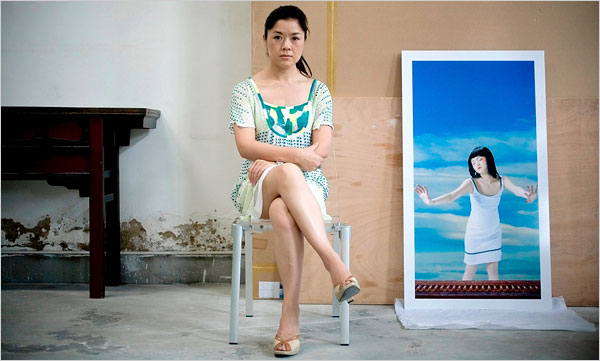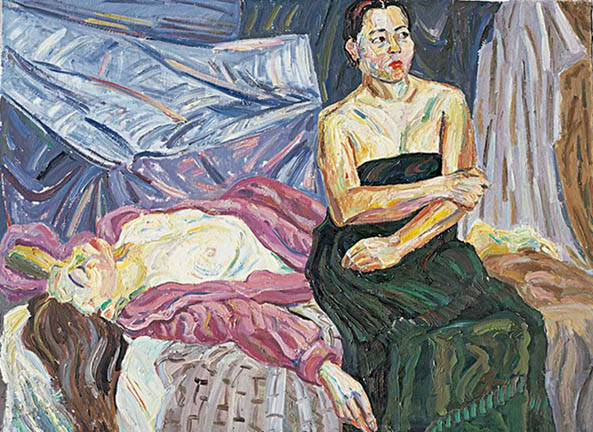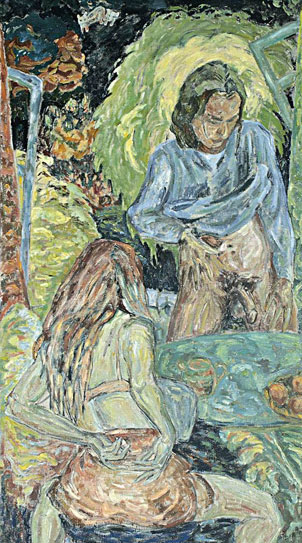Cui Xiuwen
崔
岫 闻
Painter
+ Videos *1970 Harbin, Heilongjian, studio Beijing

Cui
Xiuwen
in
her Beijing studio with 'Angel No. 9',
Photo NY
Times, 2006
Cui Xiuwen, born 1970 in Harbin,
China, graduated 1990 from the Fine Arts School of Northeast Normal
University. Then graduated from China's Central Academy Of Fine Arts,
Beijing, in 1996. In her early years, she focused on oil paintings on
canvas, while since 2004, most her works are videos and photos.
As a young avant-garde artist from
China, Cui Xiuwen has had the guts to depict female sexuality. 'Sex'
has certainly not been a taboo in the classical art of China.
Traditional Chinese culture viewed it as something that was
beneficial to physical health, and researched it in great depth. Sex
was an essential part of the extravagant, hedonistic lifestyle of
aristocratic males, and only 'forbidden' as far as the poor and women
were concerned. She resolutely took on the rôle of a feminist artist
as early as her years at the Central Academy Of Fine Arts.
Her
early paintings are, possibly for reasons of their content, ommited
from presentations of Cui's oeuvre, yet they are very strong and form
some of the best part of her work.
In this undertaking I will try to
let Ms. Cui speak for herself, wherever I can find her comments in
her autobiographical
material on her website.

Painting
shown at her first exhibition, Beijing 1995
photo CuiXiunwen
In 1997, before graduating from the
Academy of Fine Arts she produced a series of 16 oils entitled 'Rose
and Mentha', in which she depicted explitedly, though not
graphical, the relationship between a woman and a female
transvestite. - They
were shown while she was still at the Academy and predictably raised
a storm.
-
|

|

Rose
and Mentha, 1996/1997
|

|
In
her autobiographical notes (2009) Ms.
Cui recalls
“I began my artistic dialogue with the world as
early as in my oil painting series in 1996, Rose and Mentha, and the
Chuan series in 1998. The works evoked controversial responses among
the public and became a hotly debated topic among art critics and in
the media.
In these works, I completed the first phase of my
spiritual quest, i.e. the physical experience, through concrete
images. My focus at that time was to explore through painting the
relationship between the sexes, and my oil paintings at this stage
feature the public representation of the private, physical
experience.
I remember at that time a senior professor shook his
grey head after seeing my work, and sighed with the best intentions,
“why did you take up this subject, out of everything?” I shrugged
his disapproval off with a smile. My peers’ favorable reviews, on
the hand, spurred me on to my own path. A fellow male student who
came to watch me painting daily once commented, “You will
definitely become a dark horse in the artistic circle; take my word
for it.” From such kind encouragements I drew a lot of confidence
in myself.”
She
continues rather self-sure –- however
remember, by 2009 she had become famous by having her
work shown at over 70 solo and
international group exhibitions --
-
|

2009
|
“The year 1996
marks the start of my career as an independent artist. As a
graduate from the training class of Central Academy of Art, I
held an exhibition featuring 'Rose and Mentha' and other works,
which created no small stir in the spectators.
To me, that
exhibition is a prophetic sign: there had been no lack of
controversy in my later works: sexual, psychological, social,
artistic, philosophical, and so forth. In the juxtaposition of
these different angles, the spiritual essence of my art has
gradually taken shape. It, together with my life experience over
the past dozen years, has in turn found expression in the
changing style of my paintings.
|
-
An artist may start
with painting the physical while reaching for
the mind and the soul; or, she may base her work on experience at
first, and later on knowledge and philosophy. The destinations of
the two routes—the soul and philosophy—are no stranger to each
other, but interwoven and interlinked. Nevertheless, the two
routes more often than not represent a divide among contemporary
artists: artists who take the former route attend more to
sensibility, instinct, and embodied experience, while those who
follow the latter route are keener on sense, logic, and ideas.
The
former route happens to mirror my growth as an artist and as a
human being.
The following review of my serial paintings
reveals stages of my mental growth as well as my artistic
qualities and limitations. It is undeniable that if I could go
back in time, I would have painted many of these works
differently. However, the clock can never be turned back, and
imperfection lies in the very heart of art.” -
-

Selfportrait,
1997 -
-
Chuan
Series
1998
-
-
The Chuan
Series of 20 oils in 1998 shows clear influences of Max
Beckmann in subject, symbolism, and color palette – it alo
appears to have a heterosexual relationship as subject for a
change? Cui Xiuwen is obviously searching for a suitable
symbollism to express her inner turmoil.
-
Beckmann's animal symbolisms
doesn't satisfy her, and she abandons further experimentation in
painting. Apparently she went through an unspecified serious
illness in 2000 after which her brushstrokes become indecisive and
weak. In her last series of oils she turns to children and young,
troubled women.
-
-
-
-
Videos
and Photographs
-
In 2000 Cui began to explore
photography and videos as her new medium. She ceased to paint
entirely.
-
-
Videos
-
Full-length Cui videos are
practically unobtainable. Videoartworld
offers four at an exorbitant price.
-
The following is a list with
links to screenshots on Cui Xiuwen's website:
-
-
Lady's
2000
Lady's was produced with a hidden camera in the "ladies
room" of a Beijing nightclub where prostitutes are chatting
as they prepare for their clients. -
-
Toot
2001
Cui Xiuwen goes on stage and appears like a mummy, wrapped
from head to toe in toilet paper. This is the image of women
subjected to the gaze of men. Water drops slowly disintegrating
the shell, leaving the woman naked and triumphant as The Birth of
Venus by Botticelli. -
-
Sanjie
2003
Sanjie was inspired by The Last Supper by Leonardo da
Vinci. The unique figure of a young schoolgirl is playing all the
characters of the painting, magnifying their gestures. She wears a
red scarf as did the Chinese Young Pioneers. This scarf represents
a part of the Cui Xiuwen's youth. The shirt has remained very
white in her memory, although Cui Xiuwen knows that souvenirs fade
realty. The colour of history tries to erase horrors of the past.
Judas may be any of us.... -
-
Them
2005
The conversation of an older man with a young girl - in an
overexposed video strip. -
-
Red
Lanter n 2005
A red lantern as the Chinese sign of a
brothel. -
-
Spiritual
Realm 2010
-
See below.
-
-
Zixing
2011
A series of three abstract videos symbolizing the
evolving self. -
-
Photography
-
“One
Day in 2004”
2003-2006 -
-
Ms. Cui explains;
-
“Photographing the
same subject as in 'Sanjie', 'One Day in 2004' replicates the
little girl’s 'student' image—a red scarf, a white shirt, and
a checked skirt. The interpersonal relation is only suggested in
one single female character, which at that stage of my artistic
career serves as a vehicle for my reflections over female
psychology and social structure.”
-
-

Three
Realms, 2003
photo CuiXiuwen -
“The red scarf and
white shirt had been important cultural symbols from the 50s to
perhaps the 70s; even in today’s China they have largely held
their ground. To me the red scarf stands for memories of a certain
stage in my life: the aspiration for glory, the excitement and
anxiety spurred by the martyrs’ sacrifice, the identifying,
doubting, and questioning processes in the triumph of the
collective over the individual, etc. The shirt is always as white
as snow, even in our remotest dreams; it deluges everything that
is not pure. However, in reality the history is fading away, the
youngsters are growing up, and the memory seems hazier every day.
This reminds me of the controversy over which figure is Judas in
the “Last Supper”; to me Judas is nobody but we ourselves. As
I grew older, I came to realize that human beings are the simplest
and yet the most complicated creatures on earth. In this series, I
take the youngster’s innocence as the point of departure, cut
off the long maturation afterwards, and juxtapose the little girl
with the burden of history. Let the image work out its own balance
through the endless ruptures, identities, transmutations and
duplications.”
-
-
Angel
Series
2004 -

Angel
No.9, 2004
photo CuiXiuwen -
-

Angel
trapped in Chinese Society, No.3, 2004
photo CuiXiuwen -
“At the center of
the picture are red walls and red-brick historical buildings, both
emblematic of the social problems and of the human nature. The
work encapsulates the collective memory of the 1970s in China,
which has found many expressions in contemporary Chinese artworks.
Through the juxtaposition of visual aesthetics with cultural
emblems, the work probes into the submerged reefs of Chinese
society.”
-

Angel
pregnant, No.13, 2006
photo CuiXiuwen -
“She seems to be changing and
growing up among us, yet we are unaware. She is abstract and yet
real. My relationship with her is unified and yet separate.
Watching her grow up, I am often lost in the logical relationship
between me and her – her in me and me in her. My senses about
her and my relationship with her have become elongated like an
abstract memory. These are two threads, two paths of life, both in
my memory and the girl’s.”
-
-
After
Angel, A Chinese Art Paper Project
2007 -
-

After
Angel, Chinese Art Paper Project, 2007
photo CuiXiuwen -
-
Existential
Emptiness
2009 -
-

Existential
Emptiness No.3, 2009
photo CuiXiuwen -
-

Existential
Emptiness No.20, 2009
photo CuiXiuwen -
“The series 'Existential
Emptiness' represents my mental state after I entered the stage of
spiritual maturity. I began to explore issues in the mental domain
rather than dwell on the material space in my previous works.
Although in terms of formal presentation the work continues to
adopt the “student” image, it has essentially detached itself
from the material world and displayed instead, in a
three-dimensional manner, the spiritual tension between human
beings and nature and among human beings ourselves. It therefore
marks my spontaneous maturation from body to mind and spirit. In
the 3-year-long creation process from the beginning of the
conception to the actual photographing and processing, I underwent
profound extreme experiences and gleaned illuminations and
inspirations here and there. My joy and sense of fulfillment in
the spiritual growth have even overwhelmed the pleasure at the
completion of the work. It is inexplicably delicious to trot along
from the mental space to the spiritual space and from the
2-dimensional thinking to 3-dimensional thinking. I have completed
many powerful, imaginative works in my mind and will become more
creative in technical and artistic expression. Art knows no
boundaries and so do humans. Contemporary art needs to embrace
modernity, culture, spirituality, thoughts, ideas and religion.
Human beings also need to traverse freely from the material to the
mental domain, from the 2-dimensional to the 3-dimensional, from
stasis to dynamism, to representation to discovery, from function
to energy, from individual to the entire human race.”
-
-
The
Spiritual Realm
2010
-
-
The Spiritual Realm of Man and
Woman, Static
Videos, 2010
-
The group photographs are
obviously produced by digital means, which would answer the
question of how she had pursuaded her Chinese models to appear
naked in such numbers. Apart from this, the composition is
excellent.
-
-
Remarks
by Cui Xiuwen
-
“In
a sense, this work is an experiment to some extent. An attempt was
made for models to enter a natural state after they got rid of
their social roles, and then into a divine state. Here are two
problems. One is whether divinity is possible
for ordinary people.
The other is whether their potential for divinity can be
accurately expressed and presented. Some discoveries of human
nature were made in the process of this experiment....
-
Men are born with
divinity. Women are in search for gods.
-
We see a new
possibility of human nature through this work: hope, yearning and
divine power.”
-
-
Well, what's next?
-
-
-










